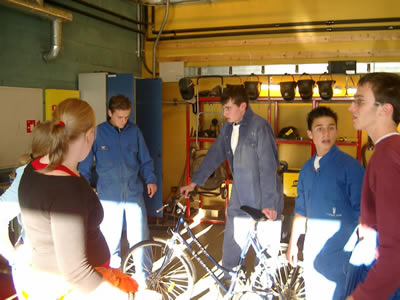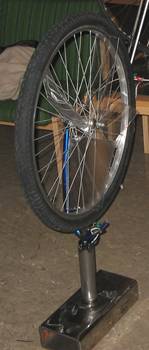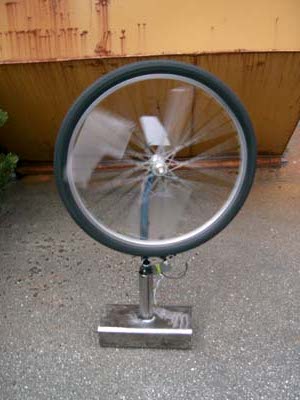Group 5.
Description of the project:
Our task was to create a windmill, which was meant to produce electrical energy. The
electrical energy would be used to make a lightbulb or lightdiode glow. We got different
materials and tools at our disposal, and then it was only our own fantasy which could limit our
options. The only requirement we had was that we had to use a bicycle dynamo to transfer the
electrical energy to the lightbulb. Our goal was to make the lightbulb glow.
How the windmill works:
With the power from the wind, we got some kind of propeller that goes around. The mechanical
energy from the propeller gets transformed into electrical energy, thanks to a dynamo or
generator. With the electrical energy, we can operate different electrical devices.
 About the group:
About the group:
Our group consisted of 4 students, two
Norwegians and two Italians. In the beginning
there were a few communication problems
between the Norwegians and the Italians. One of the
Italians had some problems with the English language, so
the other one had to translate all the
conversations. As time went by, the
communication got easier and we got more
understanding between each other. With the help
of bodylanguage and such things, we managed to
explain most of the things. As the end of the project got closer, it seemed that the Italians
actually had improved their English a bit, while the English to the Norwegians had got
worse.
The teamwork within the group went quite good. There were of course a few disagreements
and such things, but I guess you can’t avoid that when you have a group with 4 different
people with 4 different personalities.
 What was done:
What was done:
The first thing we did was to remove the front wheel of a
bike. We then started working on the base, which was a
big block of steel. We welded a tube onto the
base, and thereafter we welded the wheel in the
tube on the base.
We used plexiglas, which we assembled on the wheel,
to make the windpower get the wheel to go around.
In the end we assembled the dynamo on the wheel.
The idea of a rotor, to make the wheel adjust according to where the wind was coming from, was put on ice because of time limits. So our only solution was when the wind was coming from one direction.
How it was done:
To cut the front wheel of the bike, we simply used a motorised handheld cutting machine. Then we had a wheel on a little piece of tube. We cut one of the two sides of the fork that keeps
the wheel in place, to get more space for the plexiglas which we were to mount on the wheel a
little later on.
As I mentioned, we used a big block of steel as a base. We used a welding operation called MIG/MAG to weld on a little tube on top of the base. Then we put our wheel into that little tube piece, and welded them together.
To make the wheel get max efficiency from the wind, we used plexiglas assembled on the
wheel. We cut the plexiglas in a fitting dimension, before we mounted them. There were some
complications with getting enough space for all of the plexiglas, but we managed. To make
the plexiglas stay on the wheel, we made holes in them and used strips.
 To connect the dynamo, we cut a little piece of metal, made a small hole in the metal, and
screwed the dynamo on the metal piece. Then we welded this on one of the forks, with the
dynamo pressuring on the wheel. Wires, lightbulb and condensators had already been made by our
electrical teacher Torbjørn.
To connect the dynamo, we cut a little piece of metal, made a small hole in the metal, and
screwed the dynamo on the metal piece. Then we welded this on one of the forks, with the
dynamo pressuring on the wheel. Wires, lightbulb and condensators had already been made by our
electrical teacher Torbjørn.
When we turned on the wheel, the result was that the lightbulb started glowing actively.
Strenghts/weaknesses of our product:
The strenght of our project must be the dynamo. Only a little spinning on the wheel made
the lightbulb glow intense. So if we could get the wheel to spin, we would have lots of light.
Unfortunately, that was also one of the problems: to get the wheel spinning. This was because
of two things. We had connected the dynamo with too much pressure on the wheel, resulting
in too much friction. Therefore, the windmill needed quite strong wind to get the wheel
spinning. And then we got the other problem. The plexiglas was not constructed or planned well
enough, so we didn’t get max efficiency out of the wind, but I guess it was good enough.
Test results:
We have not seen the actual test results yet, but there’s one thing we know from that testing, that is our base was not steady enough. This made our windmill fall over when
there was too much wind. But when there was enough wind to drive the wheel around and the
base was standing, our windmill was quite effective.
 |
 |